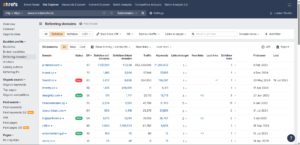Introduction
Let’s dive into competitor backlinks – think of it like creating a treasure map for your link-building strategy. You’ll want to uncover all the golden backlink opportunities that your competitors have already discovered. Take your time with this step – it’s like carefully plotting out each route on a map before a big journey.
Competitor backlinks are simply the links pointing to your rivals’ websites. They’re one of the most powerful shortcuts in SEO. Instead of starting from scratch, you can unlock the secrets to see exactly where your competitors are getting their links. Studies consistently show that top-ranking pages have significantly more backlinks than their lower-ranking competitors, so this treasure map approach really works.
What Are Competitor Backlinks (And Why Should You Care)?
When you check competitor backlinks, you’re essentially discovering which websites think that your competitors’ content is valuable enough to link to. It’s like discovering which networking events the successful people in your industry attend regularly.
Pro tip: Competitor backlink analysis isn’t just about copying what others do – it’s about understanding the link landscape and finding your own path to success. You’ll discover patterns, opportunities, and strategies that can transform your entire approach to link building.
Let’s break down the main types of backlinks you’ll discover during your backlink analysis:
1. Editorial Links: These are the golden tickets of the link world. They happen naturally when someone finds your content so useful that they can’t help but link to it. Picture a tech journalist writing about productivity apps and naturally linking to your competitor’s time-management tool because it perfectly illustrates their point.
2. Guest Post Links: These come from articles written specifically for other blogs in your industry. It’s like being invited to speak at someone else’s conference – you provide value to their audience, and they give you a link in return.
3. Directory Links: Think of these as your digital Yellow Pages listings. They might include entries in business directories, Google Business Profile, or industry-specific databases. While they’re often easier to get, they typically carry less weight than editorial links.
Real-world example: Imagine you’re running a local bakery. Your competitor analysis might reveal that three other bakeries in town are getting mentioned in the same food blogger’s articles. That blogger is probably worth connecting with as well – they’ve already shown an interest in covering businesses like yours.
Finding Your Real SEO Competitors
Here’s where many people get messed up: your SEO competitors aren’t necessarily your business competitors. Let me paint you a picture.
When you’re learning how to find competitor backlinks, you need to think beyond your direct business rivals. Imagine you sell handcrafted soap online. Your direct business competitors are other soap makers. But your SEO competitors? They might include lifestyle bloggers writing about natural skincare, health websites discussing chemical-free products, or even major publications with articles about sustainable living.
The Google Test: Start simple. Type your main keywords into Google and see who consistently shows up in the top results. These are your real SEO competitors – the ones you’re actually fighting for visibility against.
Tool-Powered Discovery: Once you’ve done your manual research, backlink checker tools can help you dig deeper. Enter your website into tools like SEMrush, Ahrefs, or even free options, and they’ll show you domains that rank for similar keywords or share backlinks with you.
Pro move? Keep a spreadsheet to track these insights. Document each competitor, their domain authority, and what types of content they’re getting links for. This becomes your competitor analysis goldmine.
Pro tip: Keep your list focused. Three to five main SEO competitors are plenty to start with. Think quality over quantity – you want to deeply understand a few rivals rather than superficially analyze dozens.
The Step-by-Step Process: How to Find Competitor Backlinks
Now the fun part – actually extracting those competitor backlinks. It’s like being a digital detective, uncovering clues about your competitors’ link building strategy.
Step 1: Input and Analyze – Fire up your chosen competitor’s backlink checker and enter your competitor’s domain. Within moments, you’ll see their entire backlink profile unfold before you. It’s like getting a behind-the-scenes look at their networking strategy.
Step 2: Filter Like a Pro-Here’s where the magic happens in your backlink analysis. You don’t want every single link – you want the good ones. Filter for dofollow links (these pass SEO value), high-authority domains, and relevant sources. Think of it like sorting through a box of mixed jewelry to find the valuable pieces
Step 3: Export and Organize-Download your filtered results into a spreadsheet. This becomes your treasure map, showing you exactly where your competitors found their most valuable links. Clean up duplicates and organize by metrics like authority score and relevance.
Step 4: Repeat and Compare-Do this for each of your main competitors. By the end, you’ll have a comprehensive database showing the link landscape in your industry.
Pro tip: When you’re learning how to find competitor backlinks, start with just one competitor and one tool. Master the process before expanding to analyze multiple rivals simultaneously.

Competitor Backlink Analysis
The Art of Link Building Strategy
Now comes the relationship-building part of your link-building strategy. Think of outreach like networking at a professional event – you’re looking to build genuine connections that benefit everyone involved.
Guest Posting: Offer to write valuable content for their audience. Instead of just asking for a link, you’re providing something useful in return. It’s like a win-win situation for both.
Broken Link Building: When you find a dead link on a target site during your competitor backlink analysis, offer your content as a replacement. You’re being helpful while creating an opportunity for yourself.
Resource Pitching: Create something genuinely better than what’s already out there, then reach out to sites linking to inferior content. It’s like showing up to a meeting with a better solution.
Personalization is Key: Always customize your outreach. Reference their specific content, show you’ve done your homework, and explain what special you can do for them. Generic emails get ignored faster than spam.
Tracking Your Success
Backlink analysis is a marathon, not a sprint. Set up systems to monitor your progress and adjust your strategy as needed.
Use tools like Google Search Console to track new backlinks, monitor your keyword rankings, and watch your organic traffic trends. The goal is steady, sustainable growth over time.
Keep an eye on your competitors, too, with regular competitor analysis. Their new links might reveal fresh opportunities or changing industry trends worth exploring.
Pro move? Set up alerts in your backlink checker tools to notify you when competitors gain significant new links. This helps you stay on top of emerging opportunities.
Common Pitfalls to Avoid
Quantity Over Quality: Resist the temptation to chase every link you find during your competitor backlink analysis. A few high-quality backlinks from authoritative, relevant sites will outperform hundreds of low-value directory links.
Ignoring Nofollow Links: While dofollow links pass more SEO value, nofollow links from quality sites still drive traffic and contribute to a natural link profile.
Black Hat Shortcuts: Avoid any manipulative tactics like paid link schemes or link farms. These might provide short-term gains, but can lead to serious penalties down the road.
Conclusion: What to do next?
Start small and build momentum with your competitor’s backlink analysis. Pick one main competitor and one competitor’s backlink checker, then work through this process step by step. You’ll quickly develop a feel for what works in your industry.
Remember, learning how to find competitor backlinks isn’t about copying – it’s about understanding the landscape and finding your own path to success. Use these insights to inform your content strategy, identify partnership opportunities, and build genuine relationships in your industry.
Ready to fast-track your competitor’s backlink analysis? Teamology’s SEO experts will identify your top link opportunities and execute proven outreach strategies to boost your rankings.
Contact us today for a free competitor analysis consultation.


